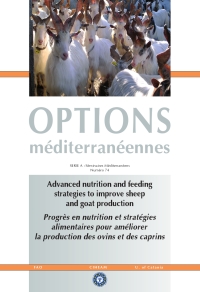| Article précédent | p. 141-145 | Article suivant |
Effect of the ratio between non-structural carbohydrates and degradable protein of concentrate on milk yield and quality of grazing Cilentana goats
Forty-five Cilentana goats were equally divided into three groups that received, as pasture supplementation, three concentrates with a different NSC:degradable protein ratio: 0.84, 0.73 and 0.60, respectively for groups A, B and C. The concentrates were fed at 200, 300 and 400 g/head/d, and at 45, 30 and 15 days before lambing, respectively. Then, the quantities increased until 800 g/head/d. After two months from lambing, the lambs were sold; the milk yield was monitored monthly for 5 controls. Each time, individual milk samples were collected and analysed for protein, fat, lactose, non-protein nitrogen and casein. Group A showed significantly higher milk yields, averaged over the whole trial period (1.463 vs 1.343 vs 1.182 kg/d, respectively for groups A, B and C; P<0.01) and a lower non-protein nitrogen percentage (0.21 vs 0.24 and 0.23, respectively for groups A, B and C; P<0.01).
Quarante-cinq chèvres Cilentana ont été également divisées en trois groupes recevant, comme supplémentation du pâturage, trois concentrés ayant différents rapports NSC/protéines dégradables : 0,84, 0,73 et 0,60, respectivement pour les groupes A, B et C. Les concentrés étaient distribués à raison de 200, 300 et 400 g/tête/j, et à 45, 30 et 15 jours avant l'agnelage, respectivement. Ensuite, les quantités augmentaient jusqu'à 800 g/tête/j. Deux mois après l'agnelage, les agneaux étaient vendus ; la production de lait était suivie mensuellement pendant 5 contrôles. Chaque fois, des échantillons individuels de lait étaient prélevés et analysés pour connaître les protéines, matière grasse, lactose, azote non protéique et caséine. Le groupe A montrait des productions de lait significativement supérieures, d'après la moyenne calculée sur toute la période de l'essai (1,463 vs 1,343 vs 1,182 kg/j, respectivement pour les groupes A, B et C ; P<0,01) et un pourcentage plus faible en azote non protéique (0,21 vs 0,24 et 0,23, respectivement pour les groupes A, B et C ; P<0,01).
- [ Télécharger ]
- [ Exporter la citation ]
Vous pouvez télécharger la citation au format :
- [ Imprimer ]
- [OMA74]




